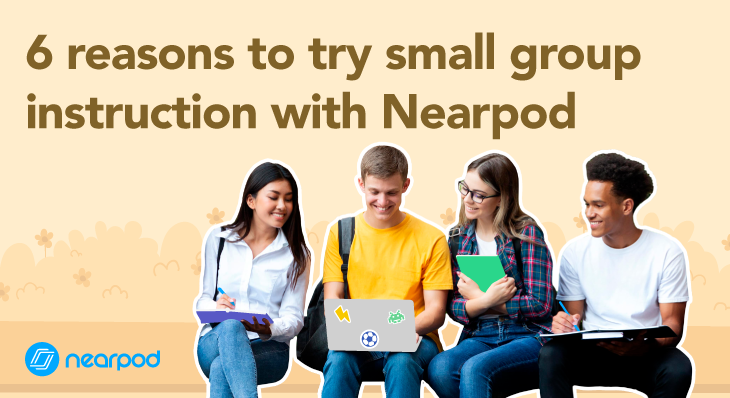
6 reasons to try small group instruction with Nearpod
This blog was written by Author and Speaker Monica Burns and originally posted on her blog ClassTechTips.com.
As a classroom teacher Nearpod was a go-to tool for both whole group and small group instruction. During my first year of using iPads with students I would often try out a new tool or tech-strategy with a small group before introducing it to the whole class. This week as I visited a second grade classroom, I had the opportunity to lead a few rotations of small group instruction. Although I use Nearpod all the time in whole group settings, this opportunity reminded me why I love using Nearpod with small groups of students too.
Right now I’m working with an amazing school here in New York to help them finish up the school year strong with tech integration. I always jump at the opportunity to model lessons in classrooms and was excited to show off some favorite strategies for elevating small group instruction with technology. A few weeks ago I shared some of the awesome ready-to-teach lessons from Nearpod. For my small group demo lesson I chose Nearpod to help me guide students through a lesson on pronouns. It was perfect for small group instruction and I outlined some of the reasons in the list below! New to Nearpod? Click here to sign up for free.
[tweetshare tweet=”Learn 6 reasons to try small group instruction with #Nearpod written by @ClassTechTips ” username=”nearpod”]Small Group Instruction with Nearpod
Annotate and draw
Whether you’re examining passages in a close reading group or asking students to draw their response to a math problem, the Draw it feature in Nearpod is perfect for small group instruction. In a strategy group you will want to watch students as they apply different skills. With Nearpod students can draw in a blank space or annotate an image on their screen.
Place resources in the hands of students
Nearpod lets teachers push lesson resources straight to student devices. This means a short passage or visual is right in front of your students, making it easy for students to reference. Instead of making copies for each student, children can access lesson resources right on their screen as you gather together in a small group.
Dive into conversations
As your students students sit in a small group they aren’t tied to their screens. You can swipe to bring a new image or slide to their attention and dive into conversations to talk about the diagram, image or video they see pop up on their screen. For example, if you have gathered a small group of students for a close reading of an image you can discuss the image together as each student refers to the image on the screen of their personal.
Find just-right resources
You might have seen my post from a few weeks ago where I featured Nearpod’s ready-to-teach lessons or their special bundles of lessons to explore. One of the challenges of small group instruction is finding resources perfect for each group of students. You can check out Nearpod’s library of lessons to find the perfect resource for your small group instruction.
Gather actionable data
You might form small groups of students as a response to data collected during whole group instruction or one-on-one conferences with students. Since Nearpod lets users check for understanding you can also use it to gather actionable data when working with small groups. Try adding an open-ended question or a multiple choice quiz to the end of your small group lesson to gather data for future follow-ups with students.
Share resources for extra practice
In addition to the live lessons you might use to lead small group instruction, Nearpod also has the open for self-paced lessons. With the self-paced option, students can revisit a lesson you’ve introduced in a small group on their own at a later date. This is a great opportunity for students to review content or a new strategy after they’ve worked with you in a small group.
If you haven’t used Nearpod before you can click here to sign up for free. It’s a favorite tool that can be used across grade levels and subject areas!

Nearpod’s award-winning platform is used by thousands of schools around the globe, transforming classroom engagement.








